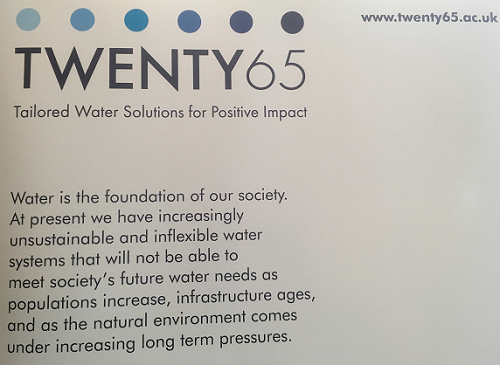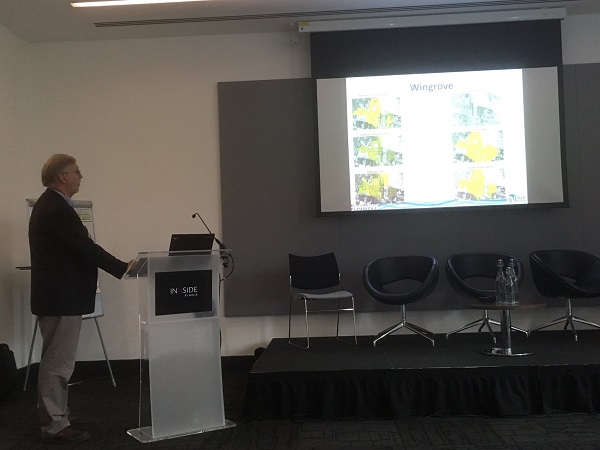
April 6, 2017, by Blue-Green team
Twenty65 Annual Conference 2017
This week I attended the Twenty65 Annual Conference 2017 – Bringing the Water Sector Together (April 4-5th, Manchester). TWENTY65, an EPSRC research project, are working in partnership across the water sector to tailor water systems so that they deliver positive impact on health, the environment, the economy and society. The conference provided an opportunity for academics, practitioners, policy makers and regulators to come together to discuss current and future challenges in the water system and ways to ensure sustainable clean water for all.
Both days began with keynote speakers followed by parallel sessions (the conference programme can be downloaded from the website and highlights were posted on twitter (@water2065)). This blog posts focusses on Day 1.
Day 1
Day 1 opened with discussions on Future Scenarios by Ronan Palmer (Director of Strategy and Planning, OFWAT) and Jon Rathjen (Water Industry Team Leader, Scottish Government). Ronan highlighted that scenario development is a process not a product, emphasising the importance of developing scenarios with a wide range of stakeholders and embedding in practice. Such long-term planning is essential to ensure resilience in the water sector where assets are typically designed with long working lifetimes. Jon discussed Scotland’s journey to become a Hydro Nation that recognises water as part of their national identity and aims to ‘make the most’ of their water resource through exporting intellectual knowledge, particularly around water governance, to other countries. Key questions discussed by the panel included:
- Will there be water ‘customers’ in 2065 or will this be increasingly self-determining?
- How can we better understand the value(s) of water?
- How can the UK best export intellectual capital associated with water governance?
- How will water be managed in future garden cities (off-grid)?
- What is the role of water companies in managing catchments?
- How can customers be better engaged around water quality, asset maintenance and water efficiency?
Discussants emphasised the importance of working with industry to develop innovative technologies well in advance and before they are needed, and engaging customers to determine what they want in terms of future water and what they are willing to pay for. There was a strong emphasis on improving customer engagement and co-production of knowledge at the same time as advancing technology and infrastructure.
Highlights
Highlights from the Day 1 parallel sessions on water efficiency and values of water included:
- The importance of linking energy and water efficiency: around a fifth of heating costs go on water so reducing hot water usage could also save energy and heating bills
- Providing people with the same message (e.g. water efficiency) in different formats and through different media (e.g. social media, advertising campaigns, flyers) may increase uptake
- We should avoid blaming people when talking about water efficiency; we are all guilty of taking water for granted!
- You cannot just have a technological solution to a social problem
- And my favourite – the problem with leaky loos – 1 in 20 homes have a leaky loo which can waste up to 400 L of water per day (Thames Water)!
Day 2
Day 2: among a wide range of keynotes and presentations on urban drainage, water futures, future technologies and social science in the water sector, Richard Fenner (University of Cambridge) gave a presentation on a new GIS methodology that allows the spatial evaluation of the multiple benefits of Blue-Green infrastructure – the Blue-Green Cities Multiple Benefit Toolbox (free to download from our website). The tool presents an alternative way to value the benefits of different courses of action and considers the local environmental factors. The tool calculates benefit intensity, spatial distribution, benefit effectiveness and potential benefits for six biophysical benefits; flood damage reduction, carbon sequestration, noise pollution reduction, air pollution reduction, habitat size increase and access to greenspace.

Richard Fenner presenting the multiple benefits GIS Toolbox and Newcastle case studies at the Twenty65 conference, April 2017
Blog post by Emily O’Donnell (University of Nottingham).
Check out the Urban Flood Resilience website to read about our research and conference participation.
No comments yet, fill out a comment to be the first

Leave a Reply